Items
Tag
CUNY
-
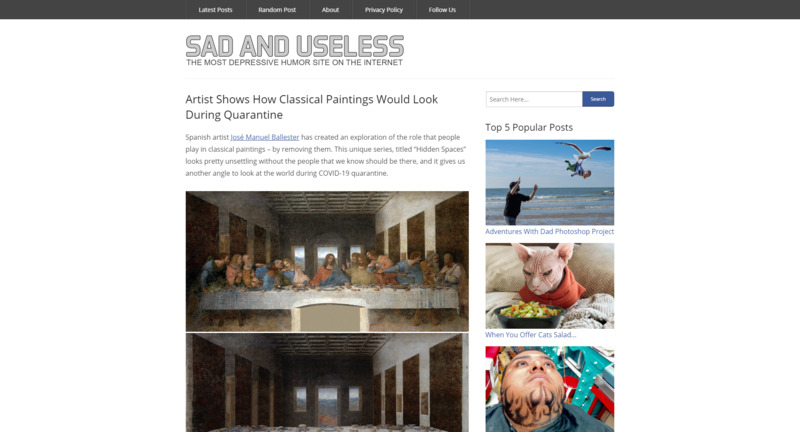 2021-05-18
2021-05-18Quarantine leaves us incomplete
Quarantine was a hard time on us all; it hit most of us out of nowhere and left us locked inside our homes for what an eternity and for most people, they had to spend that time alone. I did not go out a lot during this time so I went online and chose the pictures that I believe best represent what mine and many others felt their quarantine was like. Jose’ Manuel Ballester, a Spanish artist recreated iconic historical paintings and removed the most pivotal part in each of them; the people. Dubbed “Hidden Spaces”, Ballester recreates a series of works in which he is able to present an angle of how the world is like during quarantine. Iconic masterpieces like the Last Supper is left to just an empty table. Ballester is able to show the loneliness and emptiness that quarantine has left people in, by removing the people from the paintings Ballester thus leaving the audience with a certain feeling of discomfort reminiscent of the lack of company and interaction leaves us feeling when we are quarantined and I really resonated with these photos because that is how I felt during this quarantine. -
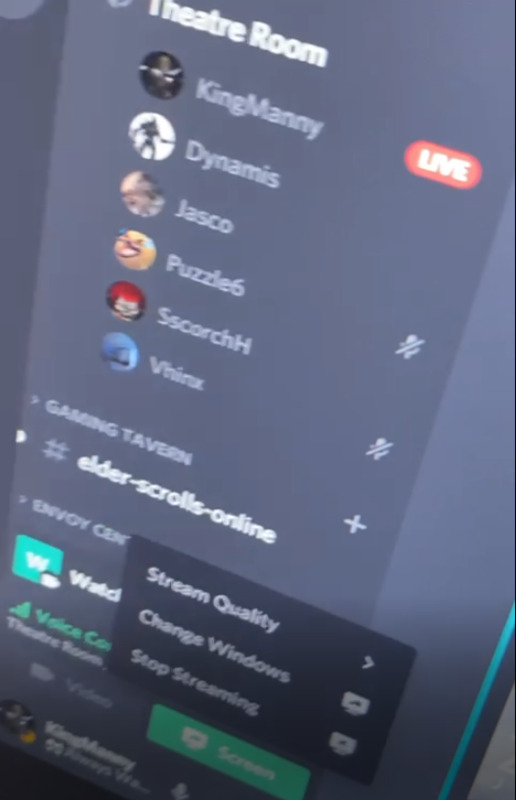 2021-05-18
2021-05-18Staying Connected
For my primary source, I selected a video/ photo that shows my discord community watching a movie together. As for the movie we were watching Justice League Snyder Cut. A movie that caused a lot of problems and controversy back in 2017. Due to Zack Snyder having to step down from the movie and Joss Whedon not a lot of people liked Whedon version. Years later Snyder released his version on HBO MAX. I created the discord server due to the COVID-19 pandemic when it started. The community has over 300 members from all over the world. With discord friends can connect directly through many ways such as voice call, video call, or text on Discord, and they can also enter servers where wider groups can connect. Discord is free to download and use just like you would use zoom or skype, but it has more to offer. Discord for me is a home. Discord allows you to establish your own sense of belonging. A discord server is your personal space, shared only with the individuals you want to invite. When I created my community on discord it was so bring people together. I started with around 10 or so friends. Anyone who joined with in the discord and wanted to invite a friend or a family member was welcomed to due so. It felt like every day we would get more and more people from all over the U.S, the UK, South America, and many places. Within my discord we help people with Homework, assignments, we host game nights as well as movies night and if some need to talk we always have people on to connect and talk to if they want someone to just listen. AS well we have text channels for memes, a place to introduce yourself when people join for everyone to read. Common games that people play and want to talk about or even just chill with some music together. With my discord community I decided to make the community because I had some free time on with school and with not working, I wanted a way to connect with my friends and family while still being under lockdown. Discord seems the best option. Anyone can connect via phone, laptop, or any web browser. I honestly did not think it would last this long or even grow this big. But then again, we did not think about that with covid-19 we thought the lock down was going to be two weeks, four weeks tops. -
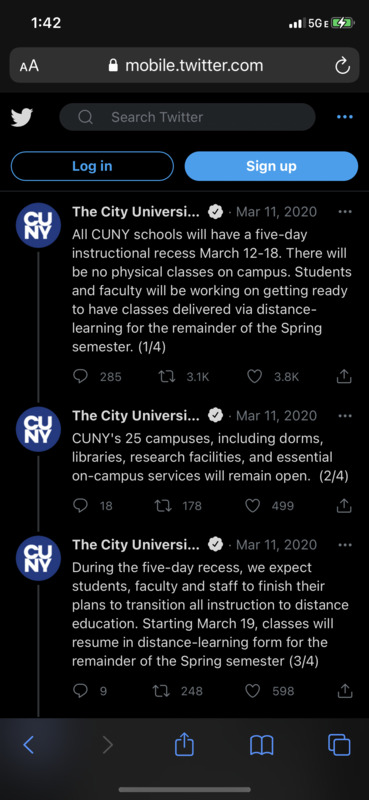 2020-03-11
2020-03-11CUNY's Response
Where to even start? 2020, the year where everything and everyone changed forever. 2020 did not just consist of the Covid Virus it consisted of many other threads that harmed everyone’s mental health including students. It was hard for all students during this time but in my perspective College students. This documents faithfully explain 2020 and I will be here to give you future historians a more in depth look at how it really was during these times. The document I chose not only explains how we went from going in person to virtual but also how it made me feel as a visual learner and as a college student of course. CUNY mentioned we were going to have a “Instructional recess from March 12-18th”, this day I will never forget because I did not know that March 11th was going to be the last day of my two-years of college. When I received this email on Twitter that CUNY had stated this I was overwhelmed and shocked. The thought of everything being virtual just didn’t seem right to me, although I did have all the access from computers to internet access, it just did not sit right. As a visual learner this was tough for me, this was a moment of you get classwork and you basically have to teach it to yourself, not seeing my professors in person and through a screen was very hard to get used to, the internet sometimes would not work and it would cut off and I would miss most of the important things said during the lesson, it was honestly very difficult, this was not just tough on students, as well as professors having the same issues. This era was honestly tough, but technology really saved a whole year worth of schoolwork. To the historians reading this in a couple of years from now, I, as a person who lived through these times want you to understand the rough time we went through, from masks to face shields to many deaths and virtually going to school. These were moments in time that no one anticipated. It shaped the future into what it had become, masks may become the new norm, working from home may be allowed for certain jobs and companies, schools just might let people continue to be fully virtual and things may be extremely dependent on technology from now on. To conclude this 2020 document, though it was a rough year where millions of people died worldwide, I can only be thankful that me and the ones I love are safe and okay. We now know how to take proper precautions in case anything like this happens again, though I don’t wish for a repeat of 2020. The year of 2020 is one for the books and one that will go down in history. -
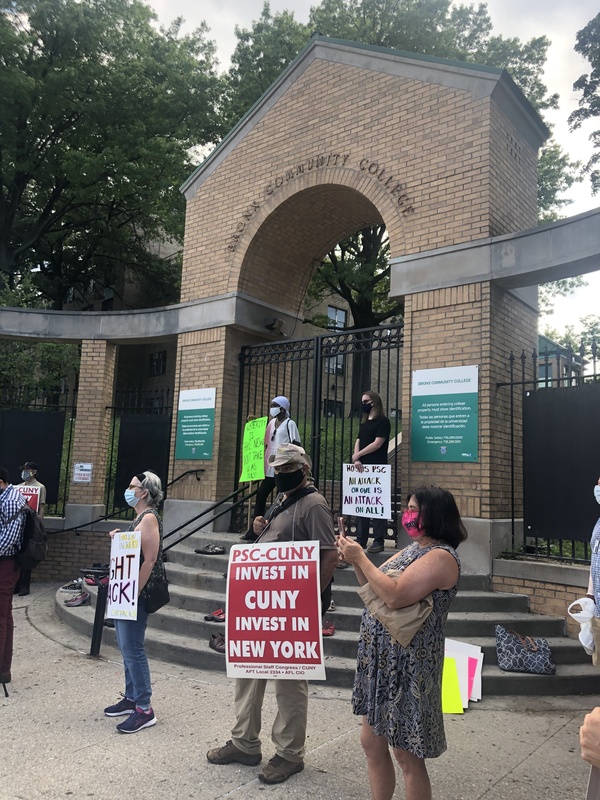 2020-07-15
2020-07-15PSC-CUNY Protest at BCC
For my primary source, I selected a photograph I took at a protest held in front of the Bronx Community College campus on July 15, 2021. The Professional Staff Union of CUNY (PSC-CUNY), the union for the faculty and much of the staff throughout CUNY, organized the event to protest the BCC administration June 26 decision to lay off 36 experienced adjunct professors at the end of their 3-year contracts, even though that their departments recommended that they be rehired. People in the picture include BCC Faculty, staff, and students, as well as those from as well as people from Hostos Community College, who came to support the BCC community and were facing similar cuts. The day was very hot, but I was nervous to the subway because of COVID, so I rode my bike from my home (about 24 miles roundtrip). I was pretty sweaty and probably stinky when I arrived. It was the first time I had been to campus since March 10, when, on my way home from school on the subway, I learned CUNY was moving online. (The campus itself was locked, but we stood in front of the gate on University.) It was also the first time I people from school in person since March; I was so happy to talk to them. It was weird to be with a group people, after months of isolation, but we all wore masks and stood six feet apart. Cars honked their support as they drove by. I selected this source because I want historians of the future to understand how the pandemic hit higher education and the connections among the COVID crisis, social justice movements, and education. Although I went to larger marches after the murder of George Floyd, I believe funding for CUNY is a form of social justice. I was angry that politicians and school administrators were giving lip-service to the phrase Black Live Manners, while cutting funding and jobs from CUNY. BCC’s students are overwhelmingly Black and Latinx, and many studies show that a CUNY education is one of the best schools for supporting social mobility, helping people support themselves and their families. Firing the adjuncts not only meant the teachers lost their income, and, sometimes, their health insurance, but that BCC students would be in larger classes; larger classes mean faculty have less time to devote to each student, which can make it harder to for students to succeed. While I understood enrollment was down and the budget from the city and state would likely be smaller because of the economic toll of the pandemic, I thought there were other places the administration could cut costs. (Such as their own salaries). I want historians to see that the faculty and staff of CUNY fought for what their students deserved and the connections among CUNY, social justice, and New York’s economic recovery. I also want them to see how people approached protests, which require gathering together with other people and often chanting or shouting, while in the middle of a pandemic that required people to stay apart and cover their mouths. -
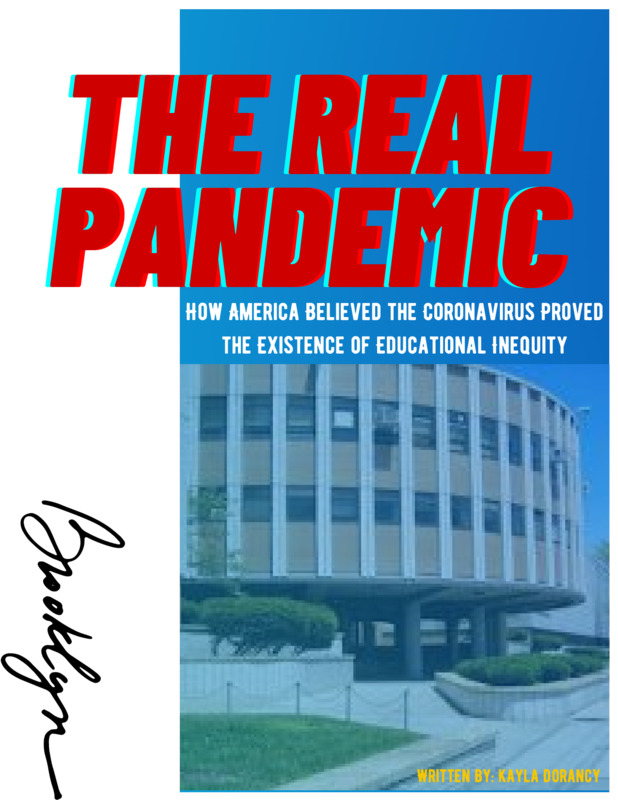 2020-03-20
2020-03-20The Real Pandemic: How America Believed the Coronavirus Proved the Existence of Educational Inequity
I am submitting an auto-ethnography on my experience as a college student in the CUNY educational system during the transition to online learning and the pandemic. -
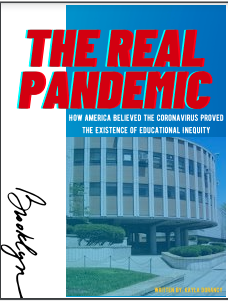 2020-08
2020-08The Real Pandemic: How America Believed The Coronavirus Proved the Existence of Educational Inequity
Several articles seek to expand the conversation of educational inequity during the pandemic in New York City public schools, however many exclude key aspects of inequality that predate the pandemic. This narrative acknowledges and challenges notions that use the pandemic to explain the inequality. It is not only my personal experience throughout the pandemic, but also the experiences around public education of me, my students, and co-workers. Amplifying the necessity for leadership, mental health, and technology to combat the concerns of racial and class retraumatization, the aspiration and achievement gap, and other aspects of inequity. In this analysis, we transform ideas about inequality in relation to [rather than caused by] the pandemic and challenge readers to think about solutions in a different way.
